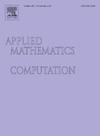耦合中间神经元的周期多稳定性和同步机制:电流刺激下的同相和反相动力学
IF 3.4
2区 数学
Q1 MATHEMATICS, APPLIED
引用次数: 0
摘要
在过去的十年中,高频振荡(HFOs),甚高频振荡(VHFOs)和超快振荡(UFOs)已被提出作为耐药癫痫患者癫痫区可能的生物标志物。尽管有相当大的兴趣,但产生如此高频率的机制,大大超过了神经元放电的生理极限,仍然是一个悬而未决的问题。利用分岔理论的概念,我们扩展了我们的数学框架来模拟明显的vhfo的出现,这可能最终表现在深度脑电图(EEG)信号中,通过纳入负责随后频率乘法的外部刺激。本研究聚焦于两个间隙连接耦合的中间神经元的动力学,提供了多稳定区域的详细分析,以及与外部电流刺激相关的可能动态机制的广泛描述,类似于单个中间神经元的频率输入曲线。特别地,我们描述了刺激激活和灭活反相或同相振荡模式的能力,包括它们的相互交换。最后,我们将此框架应用于分析大型异构双层网络的集体响应。本文章由计算机程序翻译,如有差异,请以英文原文为准。

Cycle multistability and synchronization mechanisms in coupled interneurons: In-phase and anti-phase dynamics under current stimuli
Over the last decade, high-frequency oscillations (HFOs), very high-frequency oscillations (VHFOs), and ultra-fast oscillations (UFOs) have been proposed as possible biomarkers for epileptogenic zones in individuals with drug-resistant epilepsy. Despite considerable interest, the mechanisms responsible for producing such high frequencies, significantly surpassing the physiological limits of neuronal firing, remain an open question. Using concepts from bifurcation theory, we extend our mathematical framework for modeling the emergence of apparent VHFOs, which might eventually manifest in depth electroencephalographic (EEG) signals, by incorporating an external stimulus responsible for subsequent frequency multiplication. Focusing on the dynamics of two gap-junctionally coupled interneurons, this research provides a detailed analysis of multistable regions, along with an extensive description of possible dynamical regimes associated with external current stimulation, analogous to the frequency-input curve for a single interneuron. In particular, we describe the ability of the stimulus to activate and deactivate oscillation modes in anti-phase or in-phase, including their mutual interchange. Finally, we apply this framework to analyze a collective response of a large heterogeneous two-layer network.
求助全文
通过发布文献求助,成功后即可免费获取论文全文。
去求助
来源期刊
CiteScore
7.90
自引率
10.00%
发文量
755
审稿时长
36 days
期刊介绍:
Applied Mathematics and Computation addresses work at the interface between applied mathematics, numerical computation, and applications of systems – oriented ideas to the physical, biological, social, and behavioral sciences, and emphasizes papers of a computational nature focusing on new algorithms, their analysis and numerical results.
In addition to presenting research papers, Applied Mathematics and Computation publishes review articles and single–topics issues.

 求助内容:
求助内容: 应助结果提醒方式:
应助结果提醒方式:


